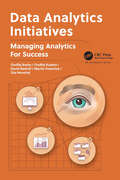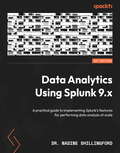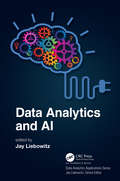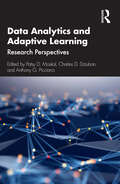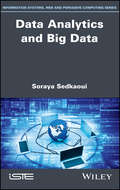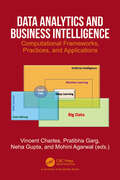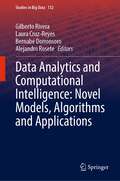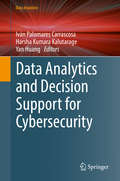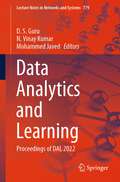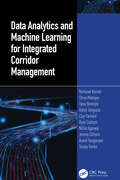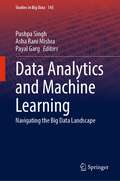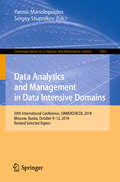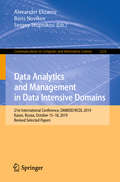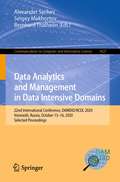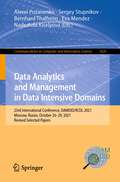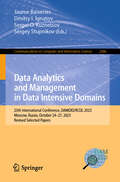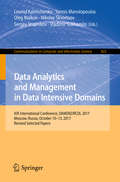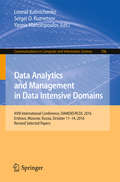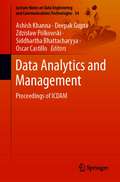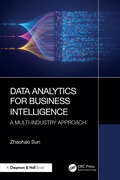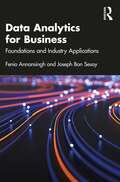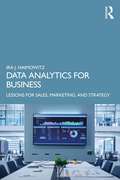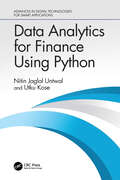- Table View
- List View
Data Analytics Initiatives: Managing Analytics for Success
by Ondřej Bothe Ondřej Kubera David Bednář Martin Potančok Ota NovotnýThe categorisation of analytical projects could help to simplify complexity reasonably and, at the same time, clarify the critical aspects of analytical initiatives. But how can this complex work be categorized? What makes it so complex? Data Analytics Initiatives: Managing Analytics for Success emphasizes that each analytics project is different. At the same time, analytics projects have many common aspects, and these features make them unique compared to other projects. Describing these commonalities helps to develop a conceptual understanding of analytical work. However, features specific to each initiative affects the entire analytics project lifecycle. Neglecting them by trying to use general approaches without tailoring them to each project can lead to failure. In addition to examining typical characteristics of the analytics project and how to categorise them, the book looks at specific types of projects, provides a high-level assessment of their characteristics from a risk perspective, and comments on the most common problems or challenges. The book also presents examples of questions that could be asked of relevant people to analyse an analytics project. These questions help to position properly the project and to find commonalities and general project challenges.
Data Analytics Made Easy: Use machine learning and data storytelling in your work without writing any code
by Andrea De Mauro Francesco Marzoni Andrew J. WalterMake informed decisions using data analytics, machine learning, and data visualizationsKey FeaturesTake raw data and transform it to add value to your organizationLearn the art of telling stories with your data to engage with your audienceApply machine learning algorithms to your data with a few clicks of a buttonBook DescriptionData analytics has become a necessity in modern business, and skills such as data visualization, machine learning, and digital storytelling are now essential in every field. If you want to make sense of your data and add value with informed decisions, this is the book for you. Data Analytics Made Easy is an accessible guide to help you start analyzing data and quickly apply these skills to your work. It focuses on how to generate insights from your data at the click of a few buttons, using the popular tools KNIME and Microsoft Power BI. The book introduces the concepts of data analytics and shows you how to get your data ready and apply machine learning algorithms. Implement a complete predictive analytics solution with KNIME and assess its level of accuracy. Create impressive visualizations with Microsoft Power BI and learn the greatest secret in successful analytics – how to tell a story with your data. You'll connect the dots on the various stages of the data-to-insights process and gain an overview of alternative tools, including Tableau and H20 Driverless AI. By the end of this book, you will have learned how to implement machine learning algorithms and sell the results to your customers without writing a line of code.What you will learnUnderstand the potential of data and its impact on any businessInfluence business decisions with effective data storytelling when delivering insightsUse KNIME to import, clean, transform, combine data feeds, and automate recurring workflowsLearn the basics of machine learning and AutoML to add value to your organizationBuild, test, and validate simple supervised and unsupervised machine learning models with KNIMEUse Power BI and Tableau to build professional-looking and business-centric visuals and dashboardsWho this book is forWhether you are working with data experts or want to find insights in your business' data, you'll find this book an effective way to add analytics to your skill stack.No previous math, statistics, or computer science knowledge is required.
Data Analytics Using Splunk 9.x: A practical guide to implementing Splunk's features for performing data analysis at scale
by Dr. Nadine ShillingfordMake the most of Splunk 9.x to build insightful reports and dashboards with a detailed walk-through of its extensive features and capabilitiesKey FeaturesBe well-versed with the Splunk 9. x architecture, installation, onboarding, and indexing data featuresCreate advanced visualizations using the Splunk search processing languageExplore advanced Splunk administration techniques, including clustering, data modeling, and container managementBook DescriptionSplunk 9 improves on the existing Splunk tool to include important features such as federated search, observability, performance improvements, and dashboarding. This book helps you to make the best use of the impressive and new features to prepare a Splunk installation that can be employed in the data analysis process.Starting with an introduction to the different Splunk components, such as indexers, search heads, and forwarders, this Splunk book takes you through the step-by-step installation and configuration instructions for basic Splunk components using Amazon Web Services (AWS) instances. You'll import the BOTS v1 dataset into a search head and begin exploring data using the Splunk Search Processing Language (SPL), covering various types of Splunk commands, lookups, and macros. After that, you'll create tables, charts, and dashboards using Splunk's new Dashboard Studio, and then advance to work with clustering, container management, data models, federated search, bucket merging, and more.By the end of the book, you'll not only have learned everything about the latest features of Splunk 9 but also have a solid understanding of the performance tuning techniques in the latest version.What you will learnInstall and configure the Splunk 9 environmentCreate advanced dashboards using the flexible layout options in Dashboard StudioUnderstand the Splunk licensing modelsCreate tables and make use of the various types of charts available in Splunk 9.xExplore the new configuration management featuresImplement the performance improvements introduced in Splunk 9.xIntegrate Splunk with Kubernetes for optimizing CI/CD managementWho this book is forThe book is for data analysts, Splunk users, and administrators who want to become well-versed in the data analytics services offered by Splunk 9. You need to have a basic understanding of Splunk fundamentals to get the most out of this book.
Data Analytics and AI (Data Analytics Applications)
by Jay LiebowitzAnalytics and artificial intelligence (AI), what are they good for? The bandwagon keeps answering, absolutely everything! Analytics and artificial intelligence have captured the attention of everyone from top executives to the person in the street. While these disciplines have a relatively long history, within the last ten or so years they have exploded into corporate business and public consciousness. Organizations have rushed to embrace data-driven decision making. Companies everywhere are turning out products boasting that "artificial intelligence is included." We are indeed living in exciting times. The question we need to ask is, do we really know how to get business value from these exciting tools? Unfortunately, both the analytics and AI communities have not done a great job in collaborating and communicating with each other to build the necessary synergies. This book bridges the gap between these two critical fields. The book begins by explaining the commonalities and differences in the fields of data science, artificial intelligence, and autonomy by giving a historical perspective for each of these fields, followed by exploration of common technologies and current trends in each field. The book also readers introduces to applications of deep learning in industry with an overview of deep learning and its key architectures, as well as a survey and discussion of the main applications of deep learning. The book also presents case studies to illustrate applications of AI and analytics. These include a case study from the healthcare industry and an investigation of a digital transformation enabled by AI and analytics transforming a product-oriented company into one delivering solutions and services. The book concludes with a proposed AI-informed data analytics life cycle to be applied to unstructured data.
Data Analytics and Adaptive Learning: Research Perspectives
by Patsy D. Moskal, Charles D. Dziuban, and Anthony G. PiccianoData Analytics and Adaptive Learning offers new insights into the use of emerging data analysis and adaptive techniques in multiple learning settings. In recent years, both analytics and adaptive learning have helped educators become more responsive to learners in virtual, blended, and personalized environments. This set of rich, illuminating, international studies spans quantitative, qualitative, and mixed-methods research in higher education, K–12, and adult/continuing education contexts. By exploring the issues of definition and pedagogical practice that permeate teaching and learning and concluding with recommendations for the future research and practice necessary to support educators at all levels, this book will prepare researchers, developers, and graduate students of instructional technology to produce evidence for the benefits and challenges of data-driven learning.
Data Analytics and Big Data: Understand Data And Take To Analytics Applications And Methods
by Soraya SedkaouiThe main purpose of this book is to investigate, explore and describe approaches and methods to facilitate data understanding through analytics solutions based on its principles, concepts and applications. But analyzing data is also about involving the use of software. For this, and in order to cover some aspect of data analytics, this book uses software (Excel, SPSS, Python, etc) which can help readers to better understand the analytics process in simple terms and supporting useful methods in its application.
Data Analytics and Business Intelligence: Computational Frameworks, Practices, and Applications
by Mohini AgarwalBusiness Analytics (BA) is an evolving phenomenon that showcases the increasing importance of using huge volumes of data to generate value for businesses. Advances in BA have offered great opportunities for organisations to improve, innovate, and develop existing or new processes, products, and services. BA is the process of transforming data into actionable insight by using statistical and mathematical analysis, descriptive, prescriptive, and predictive models, machine learning, information systems and network science methods, among others, along with a variety of data, expert knowledge, and fact-based management to support better and faster decision-making. BA and Business Intelligence (BI) generate capabilities for companies to compete in the market effectively and has become one of the main functional areas in most companies. BA tools are used in diverse ways, for example, to identify consumer behaviour patterns and market trends, to derive valuable insights on the performance of stocks, to find information on the attrition rate of employees, to analyse and solve healthcare problems, to offer insight into inventory management and supply chain management, to analyse data from social networks, and to infer traffic behaviour and develop traffic management policy, among others. BA and BI have become one of the most popular research areas in academic circles, as well as in the industry, driven by the increasing demand in the business world. This book aims to become a stimulus for innovative business solutions covering a wide range of aspects of business analytics, such as management science, information technology, descriptive, prescriptive, and predictive models, machine learning, network science, mathematical and statistical techniques. The book will encompass a valuable collection of chapters exploring and discussing computational frameworks, practices, and applications of BA that can assist industries and relevant stakeholders in decision-making and problem-solving exercises, with a view to driving competitive advantage.
Data Analytics and Computational Intelligence: Novel Models, Algorithms and Applications (Studies in Big Data #132)
by Bernabé Dorronsoro Alejandro Rosete Gilberto Rivera Laura Cruz-ReyesIn the age of transformative artificial intelligence (AI), which has the potential to revolutionize our lives, this book provides a comprehensive exploration of successful research and applications in AI and data analytics. Covering innovative approaches, advanced algorithms, and data analysis methodologies, this book addresses complex problems across topics such as machine learning, pattern recognition, data mining, optimization, and predictive modeling. With clear explanations, practical examples, and cutting-edge research, this book seeks to expand the understanding of a wide readership, including students, researchers, practitioners, and technology enthusiasts eager to explore these exciting fields. Featuring real-world applications in education, health care, climate modeling, cybersecurity, smart transportation, conversational systems, and material analysis, among others, this book highlights how these technologies can drive innovation and generate competitive advantages.
Data Analytics and Decision Support for Cybersecurity: Trends, Methodologies and Applications (Data Analytics)
by Iván Palomares Carrascosa Harsha Kumara Kalutarage Yan HuangThe book illustrates the inter-relationship between several data management, analytics and decision support techniques and methods commonly adopted in Cybersecurity-oriented frameworks. The recent advent of Big Data paradigms and the use of data science methods, has resulted in a higher demand for effective data-driven models that support decision-making at a strategic level. This motivates the need for defining novel data analytics and decision support approaches in a myriad of real-life scenarios and problems, with Cybersecurity-related domains being no exception. This contributed volume comprises nine chapters, written by leading international researchers, covering a compilation of recent advances in Cybersecurity-related applications of data analytics and decision support approaches. In addition to theoretical studies and overviews of existing relevant literature, this book comprises a selection of application-oriented research contributions. The investigations undertaken across these chapters focus on diverse and critical Cybersecurity problems, such as Intrusion Detection, Insider Threats, Insider Threats, Collusion Detection, Run-Time Malware Detection, Intrusion Detection, E-Learning, Online Examinations, Cybersecurity noisy data removal, Secure Smart Power Systems, Security Visualization and Monitoring. Researchers and professionals alike will find the chapters an essential read for further research on the topic.
Data Analytics and Learning: Proceedings of DAL 2022 (Lecture Notes in Networks and Systems #779)
by D. S. Guru N. Vinay Kumar Mohammed JavedThis book presents new theories and working models in the areas of data analytics and learning. The papers included in this volume were presented at the second International Conference on Data Analytics and Learning (DAL 2022), which was organized by the Department of Computer Science & Engineering, Alva’s Institute of Engineering & Technology, Moodbidri, Mangalore, Karnataka, India in association with the Department of Studies in Computer Science, University of Mysore, Mysuru, Karnataka, India. The areas covered include pattern recognition, image processing, deep learning, computer vision, data analytics, machine learning, artificial intelligence, and intelligent systems.
Data Analytics and Machine Learning for Integrated Corridor Management
by Sanjay Ranka Anand Rangarajan Tania Banerjee Yashawi Karnati Dhruv Mahajan Rahul Sengupta Packard Clay Ryan Casburn Nithin Agarwal Jeremy DilmoreIn an era defined by rapid urbanization and ever-increasing mobility demands, effective transportation management is paramount. This book takes readers on a journey through the intricate web of contemporary transportation systems, offering unparalleled insights into the strategies, technologies, and methodologies shaping the movement of people and goods in urban landscapes.From the fundamental principles of traffic signal dynamics to the cutting-edge applications of machine learning, each chapter of this comprehensive guide unveils essential aspects of modern transportation management systems. Chapter by chapter, readers are immersed in the complexities of traffic signal coordination, corridor management, data-driven decision-making, and the integration of advanced technologies. Closing with chapters on modeling measures of effectiveness and computational signal timing optimization, the guide equips readers with the knowledge and tools needed to navigate the complexities of modern transportation management systems.With insights into traffic data visualization and operational performance measures, this book empowers traffic engineers and administrators to design 21st-century signal policies that optimize mobility, enhance safety, and shape the future of urban transportation.
Data Analytics and Machine Learning: Navigating the Big Data Landscape (Studies in Big Data #145)
by Pushpa Singh Asha Rani Mishra Payal GargThis book presents an in-depth analysis of successful data-driven initiatives, highlighting how organizations have leveraged data to drive decision-making processes, optimize operations, and achieve remarkable outcomes. Through case studies, readers gain valuable insights and learn practical strategies for implementing data analytics, big data, and machine learning solutions in their own organizations. The book discusses the transformative power of data analytics and big data in various industries and sectors and how machine learning applications have revolutionized exploration by enabling advanced data analysis techniques for mapping, geospatial analysis, and environmental monitoring, enhancing our understanding of the world and its dynamic processes. This book explores how big data explosion, the power of analytics and machine learning revolution can bring new prospects and opportunities in the dynamic and data-rich landscape. It highlights the future research directions in data analytics, big data, and machine learning that explores the emerging trends, challenges, and opportunities in these fields by covering interdisciplinary approaches such as handling and analyzing real-time and streaming data.
Data Analytics and Management in Data Intensive Domains: 20th International Conference, DAMDID/RCDL 2018, Moscow, Russia, October 9–12, 2018, Revised Selected Papers (Communications in Computer and Information Science #1003)
by Yannis Manolopoulos Sergey StupnikovThis book constitutes the refereed proceedings of the 20th International Conference on Data Analytics and Management in Data Intensive Domains, DAMDID/RCDL 2018, held in Moscow, Russia, in October 2018.The 9 revised full papers presented together with three invited papers were carefully reviewed and selected from 54 submissions. The papers are organized in the following topical sections: FAIR data infrastructures, interoperability and reuse; knowledge representation; data models; data analysis in astronomy; text search and processing; distributed computing; information extraction from text.
Data Analytics and Management in Data Intensive Domains: 21st International Conference, DAMDID/RCDL 2019, Kazan, Russia, October 15–18, 2019, Revised Selected Papers (Communications in Computer and Information Science #1223)
by Sergey Stupnikov Boris Novikov Alexander ElizarovThis book constitutes the post-conference proceedings of the 21st International Conference on Data Analytics and Management in Data Intensive Domains, DAMDID/RCDL 2019, held in Kazan, Russia, in October 2019.The 11 revised full papers presented together with four invited papers were carefully reviewed and selected from 52 submissions. The papers are organized in the following topical sections: advanced data analysis methods; data infrastructures and integrated information systems; models, ontologies and applications; data analysis in astronomy; information extraction from text; distributed computing; data science for education.
Data Analytics and Management in Data Intensive Domains: 22nd International Conference, DAMDID/RCDL 2020, Voronezh, Russia, October 13–16, 2020, Selected Proceedings (Communications in Computer and Information Science #1427)
by Bernhard Thalheim Alexander Sychev Sergey MakhortovThis book constitutes the post-conference proceedings of the 22nd International Conference on Data Analytics and Management in Data Intensive Domains, DAMDID/RCDL 2020, held in Voronezh, Russia, in October 2020*.The 16 revised full papers and two keynotes were carefully reviewed and selected from 60 submissions. The papers are organized in the following topical sections: data Integration, conceptual models and ontologies; data management in semantic web; data analysis in medicine; data analysis in astronomy; information extraction from text.* The conference was held virtually due to the COVID-19 pandemic.
Data Analytics and Management in Data Intensive Domains: 23rd International Conference, DAMDID/RCDL 2021, Moscow, Russia, October 26–29, 2021, Revised Selected Papers (Communications in Computer and Information Science #1620)
by Bernhard Thalheim Sergey Stupnikov Alexei Pozanenko Eva Mendez Nadezhda KiselyovaThis book constitutes the post-conference proceedings of the 23rd International Conference on Data Analytics and Management in Data Intensive Domains, DAMDID/RCDL 2021, held in Moscow, Russia, in October 2021*.The 16 revised full papers were carefully reviewed and selected from 61 submissions. The papers are organized in the following topical sections: problem solving infrastructures, experiment organization, and machine learning applications; data analysis in astronomy; data analysis in material and earth sciences; information extraction from text* The conference was held virtually due to the COVID-19 pandemic.
Data Analytics and Management in Data Intensive Domains: 25th International Conference, DAMDID/RCDL 2023, Moscow, Russia, October 24–27, 2023, Revised Selected Papers (Communications in Computer and Information Science #2086)
by Dmitry I. Ignatov Jaume Baixeries Sergei O. Kuznetsov Sergey StupnikovThis book constitutes the post-conference proceedings of the 25th International Conference on Data Analytics and Management in Data Intensive Domains, DAMDID/RCDL 2023, held in Moscow, Russia, during 24-27 October 2023. The 21 papers presented here were carefully reviewed and selected from 75 submissions. These papers are organized in the following topical sections: Data Models and Knowledge Graphs; Databases in Data Intensive Domains; Machine learning methods and applications; Data Analysis in Astronomy & Information extraction from text. Papers from keynote talks have also been included in this book.
Data Analytics and Management in Data Intensive Domains: XIX International Conference, DAMDID/RCDL 2017, Moscow, Russia, October 10–13, 2017, Revised Selected Papers (Communications in Computer and Information Science #822)
by Yannis Manolopoulos Leonid Kalinichenko Oleg Malkov Nikolay Skvortsov Sergey Stupnikov Vladimir SukhomlinThis book constitutes the refereed proceedings of the 19th International Conference on Data Analytics and Management in Data Intensive Domains, DAMDID/RCDL 2017, held in Moscow, Russia, in October 2017.The 16 revised full papers presented together with three invited papers were carefully reviewed and selected from 75 submissions. The papers are organized in the following topical sections: data analytics; next generation genomic sequencing: challenges and solutions; novel approaches to analyzing and classifying of various astronomical entities and events; ontology population in data intensive domains; heterogeneous data integration issues; data curation and data provenance support; and temporal summaries generation.
Data Analytics and Management in Data Intensive Domains: XVIII International Conference, DAMDID/RCDL 2016, Ershovo, Moscow, Russia, October 11 -14, 2016, Revised Selected Papers (Communications in Computer and Information Science #706)
by Yannis Manolopoulos Leonid Kalinichenko Sergei O. KuznetsovThis book constitutes the refereed proceedings of the 28th International Conference on Data Analytics and Management in Data Intensive Domains, DAMDID/RCDL 2016, held in Ershovo, Moscow, Russia, in October 2016. The 16 revised full papers presented together with one invited talk and two keynote papers were carefully reviewed and selected from 57 submissions. The papers are organized in topical sections on semantic modeling in data intensive domains; knowledge and learning management; text mining; data infrastructures in astrophysics; data analysis; research infrastructures; position paper.
Data Analytics and Management: Proceedings of ICDAM (Lecture Notes on Data Engineering and Communications Technologies #54)
by Oscar Castillo Siddhartha Bhattacharyya Deepak Gupta Ashish Khanna Zdzisław PólkowskiThis book includes original unpublished contributions presented at the International Conference on Data Analytics and Management (ICDAM 2020), held at Jan Wyzykowski University, Poland, during June 2020. The book covers the topics in data analytics, data management, big data, computational intelligence, and communication networks. The book presents innovative work by leading academics, researchers, and experts from industry which is useful for young researchers and students.
Data Analytics for Business Intelligence: A Multi-Industry Approach
by Zhaohao SunThis book studies data, analytics, and intelligence using Boolean structure. Chapters dive into the theories, foundations, technologies, and methods of data, analytics, and intelligence.The primary aim of this book is to convey the theories and technologies of data, analytics, and intelligence with applications to readers based on systematic generalization and specialization. Sun uses the Boolean structure to deconstruct all books and papers related to data, analytics, and intelligence and to reorganize them to reshape the world of big data, data analytics, analytics intelligence, data science, and artificial intelligence. Multi-industry applications in business, management, and decision-making are provided. Cutting-edge theories, technologies, and applications of data, analytics, and intelligence and their integration are also explored. Overall, this book provides original insights on sharing computing, insight computing, platform computing, a calculus of intelligent analytics and intelligent business analytics, meta computing, data analyticizing, DDPP (descriptive, diagnostic, predictive, and prescriptive) computing, and analytics.This book is a useful resource with multi-industry applications for scientists, engineers, data analysts, educators, and university students.
Data Analytics for Business: Foundations and Industry Applications
by Fenio Annansingh Joseph Bon SesayData analytics underpin our modern data-driven economy. This textbook explains the relevance of data analytics at the firm and industry levels, tracing the evolution and key components of the field, and showing how data analytics insights can be leveraged for business results. The first section of the text covers key topics such as data analytics tools, data mining, business intelligence, customer relationship management, and cybersecurity. The chapters then take an industry focus, exploring how data analytics can be used in particular settings to strengthen business decision-making. A range of sectors are examined, including financial services, accounting, marketing, sport, health care, retail, transport, and education. With industry case studies, clear definitions of terminology, and no background knowledge required, this text supports students in gaining a solid understanding of data analytics and its practical applications. PowerPoint slides, a test bank of questions, and an instructor’s manual are also provided as online supplements. This will be a valuable text for undergraduate level courses in data analytics, data mining, business intelligence, and related areas.
Data Analytics for Business: Lessons for Sales, Marketing, and Strategy
by Ira J. HaimowitzInterest in applying analytics, machine learning, and artificial intelligence to sales and marketing has grown dramatically, with no signs of slowing down. This book provides essential guidance to apply advanced analytics and data mining techniques to real-world business applications. The foundation of this text is the author’s 20-plus years of developing and delivering big data and artificial intelligence solutions across multiple industries: financial services, pharmaceuticals, consumer packaged goods, media, and retail. He provides guidelines and summarized cases for those studying or working in the fields of data science, data engineering, and business analytics. The book also offers a distinctive style: a series of essays, each of which summarizes a critical lesson or provides a step-by-step business process, with specific examples of successes and failures. Sales and marketing executives, project managers, business and engineering professionals, and graduate students will find this clear and comprehensive book the ideal companion when navigating the complex world of big data analytics.
Data Analytics for Cultural Heritage: Current Trends and Concepts
by Abdelaziz Bouras Abdul Hamid Sadka Abdelhak Belhi Abdulaziz Khalid Al-AliThis book considers the challenges related to the effective implementation of artificial intelligence (AI) and machine learning (ML) technologies to the cultural heritage digitization process. Particular focus is placed on improvements to the data acquisition stage, as well as the data enrichment and curation stages, using advanced artificial intelligence techniques and tools. An emphasis is placed on recent applications related to deep learning for visual recognition, generative models, natural language processing, and super resolution. The book is a valuable reference for researchers working in the multidisciplinary field of cultural heritage and AI, as well as professional experts in the art and culture domains, such as museums, libraries, and historic sites and buildings. Reports on techniques and methods that leverage AI and machine learning and their impact on the digitization of cultural heritage; Addresses challenges of improving data acquisition, enrichment and management processes;Highlights contributions from international researchers from diverse fields and subject areas.
Data Analytics for Finance Using Python (Advances in Digital Technologies for Smart Applications)
by Nitin Jaglal Untwal Utku KoseUnlock the power of data analytics in finance with this comprehensive guide. Data Analytics for Finance Using Python is your key to unlocking the secrets of the financial markets.In this book, you’ll discover how to harness the latest data analytics techniques, including machine learning and inferential statistics, to make informed investment decisions and drive business success. With a focus on practical application, this book takes you on a journey from the basics of data preprocessing and visualization to advanced modeling techniques for stock price prediction.Through real-world case studies and examples, you’ll learn how to: Uncover hidden patterns and trends in financial data Build predictive models that drive investment decisions Optimize portfolio performance using data-driven insights Stay ahead of the competition with cutting-edge data analytics techniques Whether you’re a finance professional seeking to enhance your data analytics skills or a researcher looking to advance the field of finance through data-driven insights, this book is an essential resource. Dive into the world of data analytics in finance and discover the power to make informed decisions, drive business success, and stay ahead of the curve.This book will be helpful for students, researchers, and users of machine learning and financial tools in the disciplines of commerce, management, and economics.
